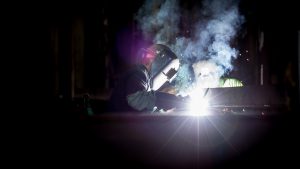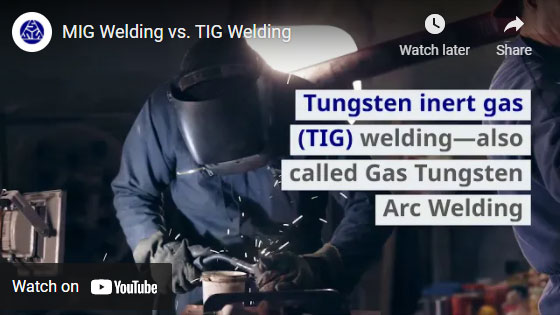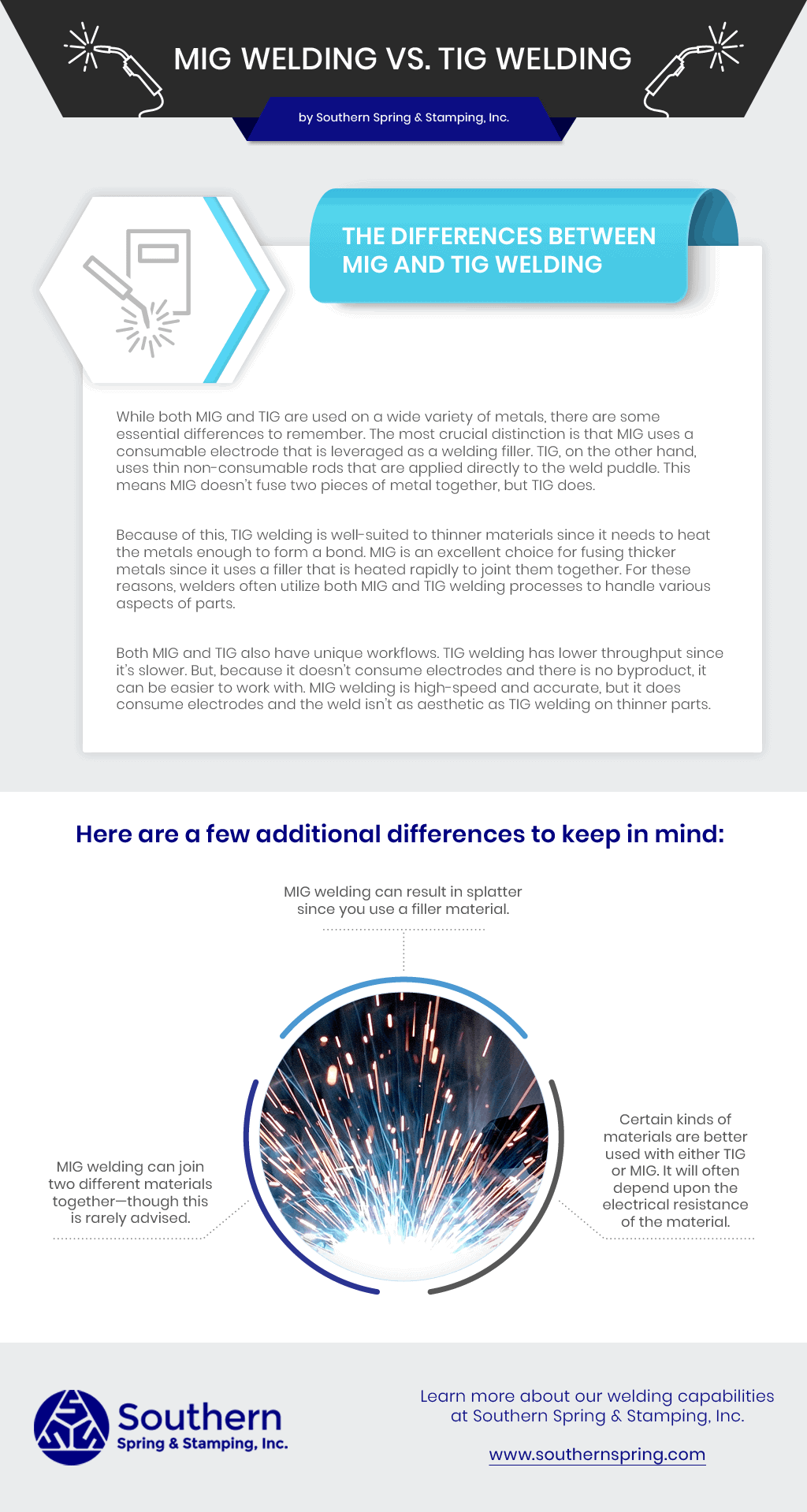Welding is the process of joining two metals (e.g., steel, iron, aluminum, copper) or thermoplastics together. There are many ways to weld materials, and each process uses unique tools and techniques. For instance, hyperbaric (or underwater) welders use arc welding to join materials on boats and oil pipelines, while NASA uses advanced techniques like friction stir welding to work on satellites in space.
Most welding jobs fall under the following categories:
- MIG welding
- TIG welding
- Stick welding
- Arc welding
Two of the most popular techniques—MIG and TIG—are used in a variety of industries to provide permanent welding to a plethora of materials.
What Is MIG Welding?
Metal inert gas (MIG) welding—also called Gas Metal Arc Welding (GMAW)—utilizes a MIG electrode wire and a specialized gun called a “MIG gun” to fuse two pieces of metal via heat. MIG guns also contain a gas bubble to prevent air from contaminating the weld.
One of the core benefits of MIG welding is the materials themselves aren’t fused together. Instead, the consumable MIG electrode is fused to both pieces of metal. This makes MIG an extremely versatile form of welding.
Here are a few details to note about this welding process:
- Since MIG guns consume both gas and the MIG electrode, both will need to be replaced occasionally. MIG welding relies on consumables.
- While MIG welding is one of the most popular welding methods, it’s not well suited for outdoor welding. Since gas is being dispersed to prevent air from contaminating the weld, drafts and wind can interfere with this process and introduce potential contaminants into the weld.
- This technique is well suited to automation.
- MIG is also one of the easiest methods for welders to learn since the gun automates many of the processes.
One of the primary reasons MIG welding is popular is that it’s incredibly easy to learn, use, and control. The MIG gun acts as the only tool, and you can start and stop each operation with the pull of a trigger.
What Is TIG Welding?
Tungsten inert gas (TIG) welding—also called Gas Tungsten Arc Welding—uses a TIG electrode and a specialized torch called a “TIG torch” to fuse two pieces of metal via heat. Unlike MIG welding, TIG does not use a consumable electrode. This means that the two pieces of metal are being fused together instead of using a filler. Like MIG welding, TIG also requires that a gas bubble be utilized to prevent weld contamination.
One core benefit of TIG welding is that the rod fed into the weld puddle is incredibly thin, so you can perform hyper-technical welds that require near-perfect aesthetics. This makes TIG extremely useful in welding situations that require incredibly clean welds—such as wires or thin parts.
Here are some more details about TIG welding to note:
- This technique is another popular choice in automation. While it’s slower than MIG, it produces less waste.
- TIG torches don’t use consumable electrodes, but they will still need gas replacement.
- It is relatively slow compared to MIG welding.
- TIG welding does not produce any splatter, which can make the welding process less messy.
The Differences Between MIG and TIG Welding
While both MIG and TIG are used on a wide variety of metals, there are some essential differences to remember. The most crucial distinction is that MIG uses a consumable electrode that is leveraged as a welding filler. TIG, on the other hand, uses thin non-consumable rods that are applied directly to the weld puddle. This means MIG doesn’t fuse two pieces of metal together, but TIG does.
Because of this, TIG welding is well-suited to thinner materials since it needs to heat the metals enough to form a bond. MIG is an excellent choice for fusing thicker metals since it uses a filler that is heated rapidly to joint them together. For these reasons, welders often utilize both MIG and TIG welding processes to handle various aspects of parts.
Both MIG and TIG also have unique workflows. TIG welding has lower throughput since it’s slower. But, because it doesn’t consume electrodes and there is no byproduct, it can be easier to work with. MIG welding is high-speed and accurate, but it does consume electrodes and the weld isn’t as aesthetic as TIG welding on thinner parts.
Here are a few additional differences to keep in mind:
- MIG welding can result in splatter since you use a filler material.
- MIG welding can join two different materials together—though this is rarely advised.
- Certain kinds of materials are better used with either TIG or MIG. It will often depend upon the electrical resistance of the material.
Contact Us for Your MIG and TIG Welding Needs
At Southern Springs, we utilize both MIG and TIG welding to create a variety of specialized parts. We recommend that you use a combination of these methods to provide the best weld and cost for your components.
We also provide high-quality sheet metal fabrication, stamping, and die processes as part of our turnkey welding solutions. Metal welding requires keen attention to detail and the ability to choose the right equipment and techniques for the right part.
Are you looking for a welder who understands these nuances and uses a strategic combination of welding methods to deliver superior results at-scale? Request a quote today.


